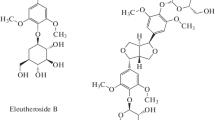Abstract
Reversed-phase high performance liquid chromatographic method was applied for the determination of eleutheroside B and E in the variousAcanthopanax species collected in Korea. The stationary phase used was Zorbax 300 SB C18 and a mobile phase program was used, which started at 6% acetonitrile for 2 min, and then a linear gradient was operated for the next 18 min to 17% acetonitrile at a flow rate of 1.0 ml/min. The column effluent was monitored at UV 210 nm. Identification was carried out by comparing the retention time and the LC/MS spectrum of each peak corresponding to eleutheroside B and E from sample with those of standards. In general, the contents of eleutheroside B and E in stems were higher than those in roots.Acanthopanax species could be classified into two groups based upon the contents of eleutheroside B and E: one group contains no or very little eleutheroside B and another contains both eleutheroside B and E.
Similar content being viewed by others
References
Farnsworth, N. R., Kinghorn, A. D., Sobe, S., Protectivejarto, D. D., and Waller, D. P., Siberian Ginseng (Eleutherococcus senticosus): Current Status as an Adaptogen, In Wagner, H., Hikino, H. and Farnsworth, N. R. (Eds.). Economic and Medicinal Plant Research. Academic Press, London, pp. 155–215, (1985).
Fujikawa, T., Yamaguchi, A., Morita, I.atoh T., and Fujisa, Takeda, H., Nishie effects ofAcanthopanax senticosus Harms from Hokkaido and its components on gastric ulcer inrestrained cold water stressed rats.Biol. Pharm. Bull., 19, 1227–1230 (1996).
Hibasami, H., Fujikawa, T., Takeda, H., Nishibe, S., Swa, T., and Nakashima, K., Induction of apoptosis byAcanthopanax senticosus HARMS and its component, sesamin in human stomach cancer KATO III cells.Oncol. Rep., 7, 1213–1216 (2000).
Kim, Y. H., Studies on the chemical components and biological activities ofAcanthopanax koreanum. Ph. D. Dissertation, Seoul National University (1986).
Kim, Y. H., Chung, B. S., and Sankawa, U., Pimaradiene diterpenes fromAcanthopanax koreanum.J. Nat. Prod., 51, 1080–1083 (1988).
Miyanomae, T. and Frindel, E., Radioprotection of hemopoiesis conferred byAcanthopanax senticosus Harms (Shigoka) administered before or after irradiation.Exp. Hematol., 16, 801–806 (1988).
Nishibe, S., Kinoshita, H., Takeda, H., and Okano, G., Phenolic compounds from stem bark ofAcanthopanax senticosus and their pharmacological effect in chronic swimming stressed rats.Chem. Pharm. Bull., 38, 1763–1765 (1990).
Park, S. Y., Chang, S. Y., Yook, C. S., and Nohara, T., New 3,4-seco-lupane-type triterpene glycosides fromAcanthopanax senticosus formainermis.J. Nat. Prod., 63, 1630–1633 (2000).
Perry, L. M. and Metzger, J.,Medicinal plants of East and Southeast of Asia. MIT Press, Cambridge, MA and London, pp. 41, (1980).
Shan, B. E., Yoshita, Y., Sugiura, T., and Yamashita, U., Suppressive effect of Chinese medicinal herb,Acanthopanax gracilistylus, extract on human lymphocytesin vitro.Clin. Exp. Immunol., 118, 41–48 (1999).
Shen, M. L., Zhai, S. K., Chen, H. L., Luo, Y. D., Tu, G. R., and Ou, D. W., Immunomopharmacological effects of polysaccharides fromAcanthopanax senticosus on experimental animals.Int. J. Immunopharmacol., 13, 549–554 (1991).
Takasugi, N., Moriguchi, T., Fuwa, T., Sanada, S., Ida, Y., Shoji, J., and Saito, H., Effect ofEleutherococcus senticosus and its rectal temperature, body and grip tones, mortor coordination, and exploratory and spontaneous movements in acute stressed mice.Shoyakugaku Zasshi, 39, 232–237 (1985).
Wang, J. Z., Tsumura, H., Shimura, K., and Ito, H., Antitumor activity of polysaccharide from a Chinese medicinal herb,Acanthopanax giraldii Harms.Cancer Lett. 65, 79–84 (1992).
Wang, J. Z., Mao, X. J., Ito, H., and Shimura, K., Immunomodulatory activity of polysaccharide fromAcanthopanax obovatus roots.Planta Med., 57, 335–336 (1991).
Yook, C. S., Lee, D. H., and Seo, Y. K., A new forma ofAcanthopanax species (I).Kor. J. Pharmacog., 7, 179–190 (1976).
Author information
Authors and Affiliations
Corresponding author
Rights and permissions
About this article
Cite this article
Kang, J.S., Linh, P.T., Cai, X.F. et al. Quantitative determination of eleutheroside B and E fromAcanthopanax species by high performance liquid chromatography. Arch Pharm Res 24, 407–411 (2001). https://doi.org/10.1007/BF02975184
Received:
Issue Date:
DOI: https://doi.org/10.1007/BF02975184




